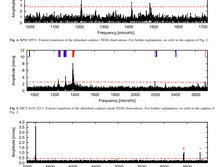ZZ Ceti or DAV stars are short-period (P ∼ 100 − 1500 s), low-amplitude (A ∼ 0.1%) variables, which means precise and short-exposure-time measurements are required both from the ground and space in order to study their pulsations. Their atmospheres are dominated by hydrogen, and they form the most populous group of pulsating white dwarf stars, lying in the 10 500– 13 000 K effective temperature range. Their pulsation modes are low-spherical-degree (ℓ = 1 and 2), and low-to-mid radialorder g-modes. The κ − γ mechanism (Dolez & Vauclair 1981; Winget et al. 1982) in combination with the convective driving mechanism (Brickhill 1991; Goldreich & Wu 1999) is responsible for the excitation of the observed pulsations. Despite the relatively narrow instability strip of the DAV stars, they can show a large variety of pulsational properties, evolving from the hot (blue) to the cool (red) edge of the instability domain. Hotter DAVs show fewer and lower-amplitude pulsation modes than the cooler ones. Furthermore, in this latter case, above about 800 s in period, we usually do not detect one single peak at a given frequency in the Fourier transform of the light curve, but a large number of peaks under a broad envelope, which is reminiscent of stochastically driven oscillations. We refer the reader to Hermes et al. (2017) for a detailed description of both the DAV instability strip and this interesting phenomenon based on observations with the Kepler space telescope. For reviews of the theoretical and observational aspects of studies of white dwarf pulsators, we also recommend the papers of Winget & Kepler (2008), Fontaine & Brassard (2008), Althaus et al. (2010), Córsico et al. (2019), and Córsico (2020). We also mention the so-called outburst phenomena in cool DAV stars, which appears as an increase in the stellar flux of ZZ Ceti stars close to the red edge of the instability strip. These outburst events were discovered using the measurements of the Kepler space telescope; see the papers of Keaton Bell and his collaborators: Bell et al. (2015, 2016, 2017), and also Hermes et al. (2015). Such phenomena suggest that the average brightness of the star increases relatively quickly (in about 1 hour) and by at least several per cent, and remains in this state for several hours or even longer, sometimes for even more than 1 day. After that, the stellar brightness decreases to the initial value; the outburst event repeats after several days or weeks. The duration and occurrence of these events is irregular and unpredictable. Bell et al. (2017) discuss a possible explanation for the outbursts: non-linear mode coupling, which can transfer energy from a driven parent mode into two daughter modes. In this case, these otherwise damped daughter modes will deposit the additional energy at the base of the convection zone, and we observe the resulting surface heating of the star. This pulsational energy-transfer mechanism could explain the observed location of the cool edge of the ZZ Ceti instability strip, which should be much cooler according to theoretical calculations. However, Montgomery et al. (2020) raised another possibility, namely that phase shifts of the travelling waves reflected from the outer turning point being close to the convection zone could also be relevant in explaining the outburst phenomenon. This paper focuses on the study of ZZ Ceti stars observed by the Transiting Exoplanet Survey Satellite (TESS; Ricker et al. 2015). TESS was launched on 18 April 2018, and during its two-year primary mission, it provided 30 minute (long-)cadence full-frame images from almost the entire sky, and 120 second (short-)cadence observations on selected targets. The main goal of the mission is to find exoplanets at bright nearby stars with the transit method, but the time sampling of the observations also allows us to examine the pulsations of stars in the observed fields. Due to their short periods, only the short cadence mode is suitable for studying the light variations of compact pulsators. The first-light papers of the TESS Asteroseismic Science Consortium (TASC) Compact Pulsators Working Group (WG#8), presented for example by Bell et al. (2019), Charpinet et al. (2019), and Bognár et al. (2020), clearly demonstrate the suitability of TESS measurements for compact pulsators. Moreover, TESS observations have significantly raised (by about 20 per cent) the number of known DAV stars (Romero et al. 2022). Fortunately, the Extended Mission was approved for 2020– 2022, with some modifications, for example in the cadence of\ the observations. The full-frame image cadence was reduced to 10 minutes, and a new, 20-second ultrashort cadence mode was implemented. The latter in particular was a welcome addition given the short periods seen in compact pulsators. This paper is the continuation of our work published in 2020 (Bognár et al. 2020, hereafter P01). We detail the main goals of the present work and some points about the light curve reduction process in Sect. 2. Section 3 presents the results of the lightcurve analyses, while Sect. 4 summarises our asteroseismic investigations. Finally, the summary and conclusions are presented in Sect. 5.































